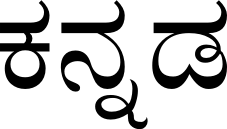Difference between revisions of "Language/Kannada/Grammar/Future-Tense"
m (Quick edit) |
m (Quick edit) |
||
| Line 8: | Line 8: | ||
__TOC__ | __TOC__ | ||
<span link>With the completion of this lesson, consider investigating these related pages: [[Language/Kannada/Grammar/Give-your-Opinion|Give your Opinion]] & [[Language/Kannada/Grammar/How-to-Use-Have|How to Use Have]].</span> | |||
== Formation == | == Formation == | ||
In Kannada, the future tense is formed by adding the suffix "-oḍu" to the end of the verb in the infinitive form. Infinitive verbs in Kannada end in "-u". | In Kannada, the future tense is formed by adding the suffix "-oḍu" to the end of the verb in the infinitive form. Infinitive verbs in Kannada end in "-u". | ||
| Line 73: | Line 75: | ||
To improve your [[Language/Kannada|Kannada]] [[Language/Kannada/Grammar|Grammar]], you can also use the [https://polyglotclub.com Polyglot Club] website. [https://polyglotclub.com/find-friends.php?search=send&d=0&f=36&offre1=64 Find native speakers] and ask them any [https://polyglotclub.com/language/kannada/question questions]! | To improve your [[Language/Kannada|Kannada]] [[Language/Kannada/Grammar|Grammar]], you can also use the [https://polyglotclub.com Polyglot Club] website. [https://polyglotclub.com/find-friends.php?search=send&d=0&f=36&offre1=64 Find native speakers] and ask them any [https://polyglotclub.com/language/kannada/question questions]! | ||
<span class='maj'></span> | <span class='maj'></span> | ||
| Line 86: | Line 87: | ||
|description=In this lesson, you will learn about the Future Tense in Kannada grammar. We will illustrate the lesson with cultural information and interesting facts. Use this lesson to improve your understanding of Kannada Grammar! | |description=In this lesson, you will learn about the Future Tense in Kannada grammar. We will illustrate the lesson with cultural information and interesting facts. Use this lesson to improve your understanding of Kannada Grammar! | ||
}} | }} | ||
==Videos== | ==Videos== | ||
| Line 103: | Line 102: | ||
<youtube>https://www.youtube.com/watch?v=V_fkFHE9ur0</youtube> | <youtube>https://www.youtube.com/watch?v=V_fkFHE9ur0</youtube> | ||
==Other Lessons== | |||
== | |||
* [[Language/Kannada/Grammar/Adjectives|Adjectives]] | * [[Language/Kannada/Grammar/Adjectives|Adjectives]] | ||
* [[Language/Kannada/Grammar/Pronouns|Pronouns]] | * [[Language/Kannada/Grammar/Pronouns|Pronouns]] | ||
| Line 123: | Line 121: | ||
[[Category:0-to-A1-Course]] | [[Category:0-to-A1-Course]] | ||
[[Category:Kannada-0-to-A1-Course]] | [[Category:Kannada-0-to-A1-Course]] | ||
<span links></span> | |||
Revision as of 21:59, 27 March 2023
Hi Kannada learners! 😊
In this lesson, we will be discussing the future tense in Kannada grammar. The future tense is used to describe an action that will happen or will be completed.
With the completion of this lesson, consider investigating these related pages: Give your Opinion & How to Use Have.
Formation
In Kannada, the future tense is formed by adding the suffix "-oḍu" to the end of the verb in the infinitive form. Infinitive verbs in Kannada end in "-u".
Example:
| Kannada | Pronunciation | English |
|---|---|---|
| ಬರು | "Baru" | to come |
| ಬರುವುದು | "Baruvudu" | coming |
| ಬರುವುದುಂಟು | "Baruvuduntu" | is coming |
| ಬರುವುದುಂಟುಕೊಳ್ಳೋಣ | "Baruvuduntukolloṇa" | Let's come |
| ಬರುವುದುಂಟುಮಾಡುವುದು | "Baruvuduntumāḍuvudu" | is making it certain to come |
| ಬರುವುದುಂಟುಮಾಡಬೇಕು | "Baruvuduntumāḍabēku" | should make it certain to come |
| ಬರುವುದುಂಟುಮಾಡಿದೆ | "Baruvuduntumāḍide" | has made it certain to come |
| ಬರುವುದುಂಟುಮಾಡಿಸು | "Baruvuduntumāḍisu" | make it certain to come |
| ಬರುವುದುಂಟುಮಾಡಿಸಲು | "Baruvuduntumāḍisalu" | to make it certain to come |
| ಬರುವುದುಂಟೆ | "Baruvudunte" | comes |
Examples
Here are a few examples of sentences using the future tense in Kannada:
| Kannada | Pronunciation | English |
|---|---|---|
| ನಾಳೆ ಬರುತ್ತೇನೆ. | "Nāḷe baruṭṭēne." | I will come tomorrow. |
| ಆಹಾರ ಮರೆಯುವುದು ಖರೀದಿಸುವ ಜೊತೆಯಲ್ಲಿ ಮತ್ತೆ ಹೆಚ್ಚಿನ ಪಾವತಿಗಳನ್ನು ತೆಗೆದುಕೊಳ್ಳುವೆ. | "Āhāra mareyuvudu kharīḍisuv jōtēyalli mattē hecchina pāvatigaḷannu tegedukolluve." | While grocery shopping, I will also take more discounts. |
| ಅವಳು ನಾಳೆ ಬರುವಳು. | "Avḷu nāḷe baruvuḷu." | She will come tomorrow. |
Dialogue
Here's an example dialogue to help you understand the future tense in context:
- Person 1: ನೀವು ಸಂತೋಷದಿಂದ ಬನ್ನಿ. (Nīvu santōṣadin̄di bandi.) (You should come happily.)
- Person 2: ಹೌದು, ನಾನು ಮಂಡ್ಯಕ್ಕೆ ಕೋರ್ಟಿಗೆ ನಾಳೆ ಬರುತ್ತೇನೆ. (Haudu, nānu maṇḍyakke kōrṭige nāḷe baruṭṭēne.) (Yes, I am coming to Mandya court tomorrow.)
Usage
It's important to know when and where to use the future tense in Kannada grammar. It's primarily used when referring to future events or actions. However, it can also be used to express a future probability or likelihood. Here are a few more examples:
| Kannada | Pronunciation | English |
|---|---|---|
| ಅವನು ನಾಳೆ ಸ್ವಲ್ಪ ವಿಶ್ರಮ ಮಾಡಿಕೊಳ್ಳುವನು. | "Avanu nāḷe swalpa vishrama māḍikolluvanu." | He will take some rest tomorrow. |
| ನೀವು ಮಗುವಿನಿಂದ ರಕ್ಷಿಸುವಿರಾ? | "Nīvu maguvindra rakṣisuvi'rā?" | Will you protect the baby? |
Tips
To help you master the future tense in Kannada, here are a few tips: - Practice, practice, practice! The more you use the future tense in speaking and writing, the more familiar you will become with it. - Pay attention to sentence structure. Unlike in English, the verb is placed at the end of the sentence in Kannada. - Keep a vocabulary list of common future tense verbs handy. This will help you practice using the correct tense when you need it.
To improve your Kannada Grammar, you can also use the Polyglot Club website. Find native speakers and ask them any questions!
Sources
- Verbs in Kannada | Learn future tense verbs ... - Learn Kannada Online
- Kannada Grammar - Future Tense
- Pin on Kannada
Videos
Simple Sentences In Past Present Future Tense - Kannada ...
Everyday Grammar||Past, Present And Future Tense In Kannada ...
Kannada Grammar - Tenses - Past, Present & Future tense - YouTube
Simple Future Tense | English grammar in Kannada - YouTube
Other Lessons
- Adjectives
- Pronouns
- Questions
- Nouns
- Give your Opinion
- Negation
- How to Use Be
- Conditional Mood
- Gender
